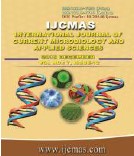


 National Academy of Agricultural Sciences (NAAS)
National Academy of Agricultural Sciences (NAAS)

|
PRINT ISSN : 2319-7692
Online ISSN : 2319-7706 Issues : 12 per year Publisher : Excellent Publishers Email : editorijcmas@gmail.com / submit@ijcmas.com Editor-in-chief: Dr.M.Prakash Index Copernicus ICV 2018: 95.39 NAAS RATING 2020: 5.38 |
Most of the farmers with extensive poverty in Surguja dominated by rainfed ecologies where rice is the principal source of staple food, employment, and income for the rural population. Success has been limited in increasing productivity in rainfed rice systems. The study based on primary as well as secondary data was carried out in Nine selected villages of batauli block of Surguja district of Chhattisgarh. Primary data were collected from a sample of 30 farmers spread over the study area, constituting 10 marginal, 15 small and 5 big farmers who were selected using probability proportional to size method for the study. The total Yield Gap in rice production was worked out as the summation of Yield Gap I and Yield Gap-II, which was estimated as 6.75 q/ha on big size, 9.55 q/ha on small size and 11.13 q/ha on marginal size farms and on an average, it was 9.14 q/ha. On the whole, the estimated value of Index of Realized Potential Farm Yield (IRPFY) was found to be 85.63 per cent, whereas the Index of Realized Potential Yield (IRPY) was observed as 69.52 %. An overall Index of Yield Gap was estimated as 30.48 %. It may be inferred from the study that the proper utilization of recommended package and practices of aromatic rice along with the supply of quality inputs viz. seeds, fertilizers, irrigation and plant protection measures on different categories of farms may help reduce the yield gap of the crop on the one hand and raise the income of the farmers on the other.
 |
 |
 |
 |
 |